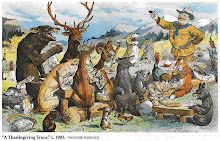Rising temperatures and decreased snowfall spell trouble for Canada lynx
Maine facing loss of Canada lynx population as the wild cat and its primary prey, the snowshoe hare, migrate to snowier pastures Maine can no longer provide.
Canada lynx are uniquely suited for the rigors of life in snowy northern Maine. The furry feline's thick coat, long and lean legs and massive paws allow it to hunt atop snowpack like a cat on snowshoes. But with temperatures predicted to rise in the coming years, the deep snow cover that the lynx depends on may be significantly reduced, eliminating its competitive advantage over other predators.
The U.S. Fish and Wildlife Service officially listed Canada lynx as a threatened species in 13 states in 2000. As a federally threatened species whose range has already been greatly diminished, this rare wildcat faces a grave threat in climate change. "It is hypothesized that as the climate warms, the lynx range will recede and move north," said John Organ, chief of Wildlife and Sport Fish Restoration for the Service in the Northeast Region. "Without significant snow cover, Maine's lynx population could be in jeopardy."
"Lynx are uniquely sensitive to climate change based on their physical attributes," said Chris Hoving, Endangered Species Coordinator for the Michigan Department of Natural Resources and Environment. "Their preferred habitat requires at least 2.7 meters of average annual snowfall. If snowfall decreases, there may be almost no suitable habitat in Maine, where the only verifiable lynx population on the East Coast exists."
State and federal conservation agencies are developing strategies to maintain Maine's lynx population. Part of that includes providing ample habitat for the snowshoe hare. "As the hare goes, so goes the lynx," said Organ. "Providing guidance to land managers — within the context of larger biodiversity concerns — is critical to the success of lynx and all species."
This story was written by Bill Butcher and Frank Wolff for the U.S. Fish & Wildlife Service









No comments:
Post a Comment